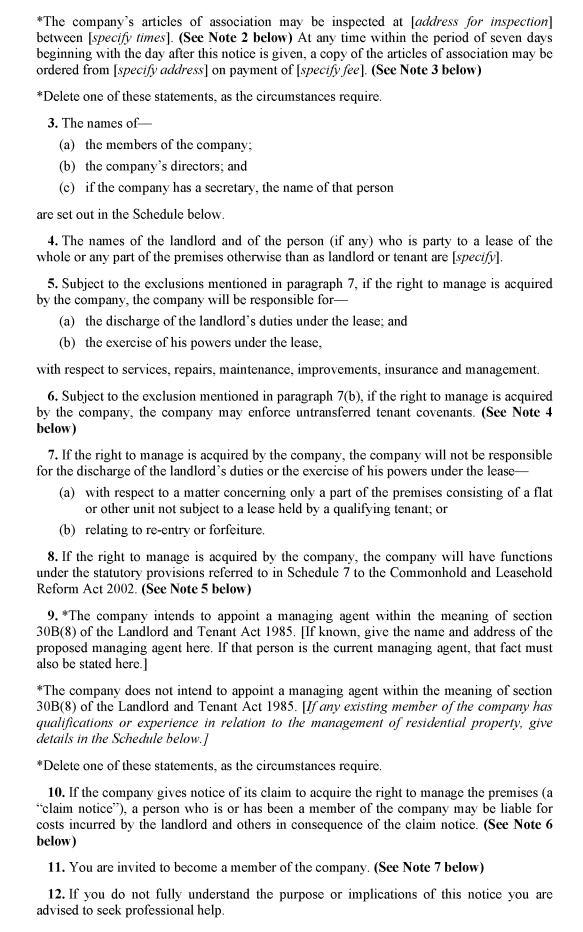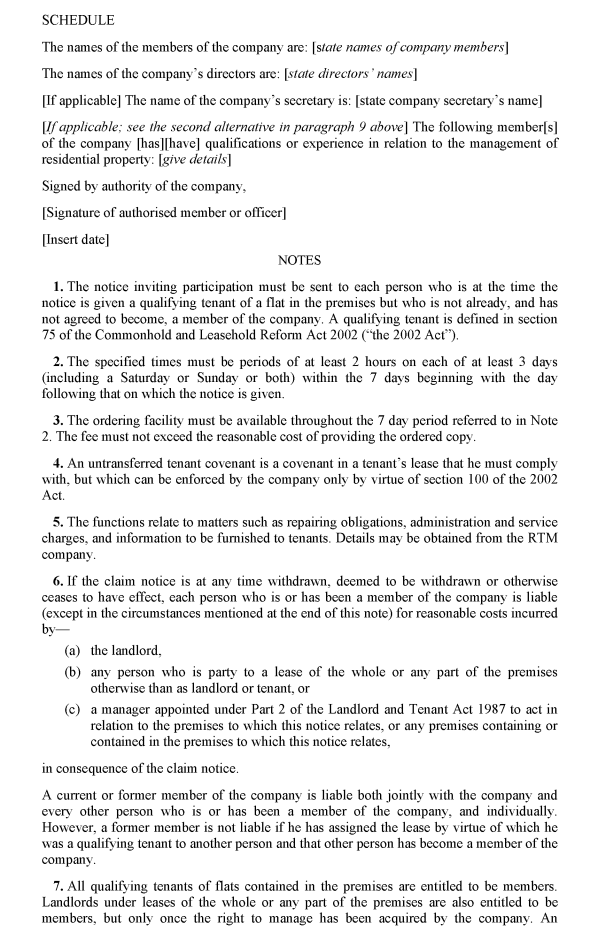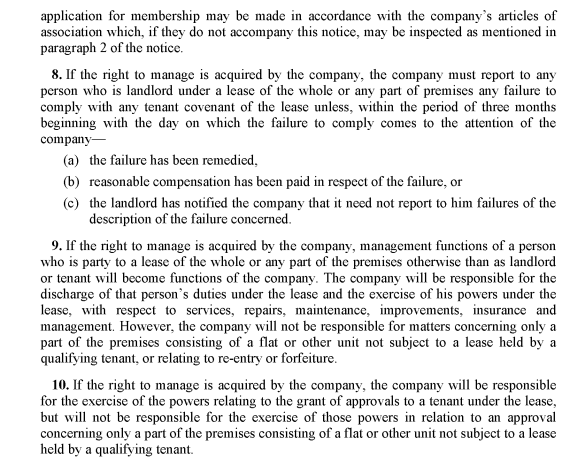- Latest available (Revised)
- Original (As made)
The Right to Manage (Prescribed Particulars and Forms) (England) Regulations 2010
You are here:
- UK Statutory Instruments
- 2010 No. 825
- Whole Instrument
- Previous
- Next
More Resources
Status:
This is the original version (as it was originally made). This item of legislation is currently only available in its original format.
Statutory Instruments
2010 No. 825
Landlord And Tenant, England
The Right to Manage (Prescribed Particulars and Forms) (England) Regulations 2010
Made
17th March 2010
Laid before Parliament
24th March 2010
Coming into force
19th April 2010
Citation, commencement and application
1.—(1) These Regulations may be cited as the Right to Manage (Prescribed Particulars and Forms) (England) Regulations 2010 and shall come into force on 19h April 2010.
(2) These Regulations apply in relation to premises in England only.
Interpretation
2. In these Regulations—
“the 2002 Act” means the Commonhold and Leasehold Reform Act 2002;
“landlord”, in relation to RTM premises, means a person who is landlord under a lease of the whole or any part of the premises(3);
“RTM premises” means premises as regards which a RTM company intends to acquire the right to manage(4);
“third party”, in relation to RTM premises, means a person who is party to a lease of the whole or any part of the premises otherwise than as landlord or tenant(5).
Additional content of notice of invitation to participate
3.—(1) A notice of invitation to participate shall contain, in addition to the statements and information referred to in section 78(2)(a) to (c) of the 2002 Act (notice inviting participation), the particulars mentioned in paragraph (2).
(2) The particulars referred to in paragraph (1) are—
(a)the RTM company’s registered number(6), the address of its registered office and the names of its directors and if applicable, secretary;
(b)the names of the landlord and any third party;
(c)a statement that, subject to the exclusions mentioned in sub-paragraph (e), if the right to manage is acquired by the RTM company, the company will be responsible for—
(i)the discharge of the landlord’s duties under the lease; and
(ii)the exercise of his powers under the lease,
with respect to services, repairs, maintenance, improvements, insurance and management;
(d)a statement that, subject to the exclusion mentioned in sub-paragraph (e)(ii), if the right to manage is acquired by the RTM company, the company may enforce untransferred tenant covenants(7);
(e)a statement that, if the right to manage is acquired by the RTM company, the company will not be responsible for the discharge of the landlord’s duties or the exercise of his powers under the lease—
(i)with respect to a matter concerning only a part of the premises consisting of a flat or other unit not subject to a lease held by a qualifying tenant(8); or
(ii)relating to re-entry or forfeiture;
(f)a statement that, if the right to manage is acquired by the RTM company, the company will have functions under the statutory provisions referred to in Schedule 7 to the 2002 Act;
(g)a statement that the RTM company intends or, as the case may be, does not intend, to appoint a managing agent; and—
(i)if it does so intend, a statement—
(aa)of the name and address of the proposed managing agent (if known); and
(bb)if it be the case, that the person is the landlord’s managing agent; or
(ii)if it does not so intend, the qualifications or experience (if any) of the existing members of the RTM company in relation to the management of residential property;
(h)a statement that, where the RTM company gives a claim notice, a person who is or has been a member of the company may be liable for costs incurred by the landlord and others in consequence of the notice;
(i)a statement that, if the recipient of the notice (of invitation to participate) does not fully understand its purpose or implications, he is advised to seek professional help; and
(j)the information provided in the notes to the form set out in Schedule 1 to these Regulations.
Additional content of claim notice
4. A claim notice shall contain, in addition to the particulars required by section 80(2) to (7) (contents of claim notice) of the 2002 Act—
(a)a statement that a person who—
(i)does not dispute the RTM company’s entitlement to acquire the right to manage(9); and
(ii)is the manager party under a management contract(10) subsisting immediately before the date specified in the claim notice,
must, in accordance with section 92 of the 2002 Act (duties to give notice of contracts), give a notice to the RTM company and to the person who is the contractor party;
(b)a statement that, from the acquisition date(11), landlords under leases of the whole or any part of the premises to which the claim notice relates are entitled to be members of the RTM company;
(c)a statement that the notice is not invalidated by any inaccuracy in any of the particulars required by section 80(2) to (7) of the 2002 Act or this regulation, but that a person who is of the opinion that any of the particulars contained in the claim notice are inaccurate may—
(i)identify the particulars in question to the RTM company by which the notice was given; and
(ii)indicate the respects in which they are considered to be inaccurate;
(d)a statement that a person who receives the notice but does not fully understand its purpose, is advised to seek professional help; and
(e)the information provided in the notes to the form set out in Schedule 2 to these Regulations.
Additional content of counter-notice
5. A counter-notice shall contain (in addition to the statement referred to in paragraph (a) or (b) of section 84(2) (counter-notices) of the 2002 Act)—
(a)a statement that, where the RTM company has been given one or more counter-notices containing such a statement as is mentioned in paragraph (b) of section 84(2) of the 2002 Act, the company may apply to a leasehold valuation tribunal for a determination that, on the date on which notice of the claim was given, the company was entitled to acquire the right to manage the premises specified in the claim notice;
(b)a statement that, where the RTM company has been given one or more counter-notices containing such a statement as is mentioned in paragraph (b) of section 84(2) of the 2002 Act, the company does not acquire the right to manage the premises specified in the claim notice unless—
(i)on an application to a leasehold valuation tribunal, it is finally determined(12) that the company was entitled to acquire the right to manage the premises; or
(ii)the person by whom the counter-notice was given agrees, or the persons by whom the counter-notices were given agree, in writing that the company was so entitled; and
(c)the information provided in the notes to the form set out in Schedule 3 to these Regulations.
Additional content of contractor notice
6. A contractor notice(13) shall contain (in addition to the particulars referred to in paragraphs (a) to (d) of section 92(3) (duties to give notice of contracts) of the 2002 Act) the statement that, should the person to whom the notice is given wish to provide to the RTM company services which, as the contractor party, it has provided to the manager party(14) under the contract, it is advised to contact the RTM company at the address given in the notice.
Additional content of contract notice
7. A contract notice shall contain (in addition to the particulars referred to in section 92(7)(a) of the 2002 Act)—
(a)the address of the person who is the contractor party, or sub-contractor party(15), under the contract of which particulars are given in the notice; and
(b)a statement that, should the RTM company wish to avail itself of the services which the contractor party, or sub-contractor party, has provided to the manager party under that contract, it is advised to contact the contractor party, or sub-contractor party, at the address given in the notice.
Form of notices
8.—(1) Notices of invitation to participate shall be in the form set out in Schedule 1 to these Regulations.
(2) Claim notices shall be in the form set out in Schedule 2 to these Regulations.
(3) Counter-notices shall be in the form set out in Schedule 3 to these Regulations.
Revocation and transitional provision
9.—(1) The Right to Manage (Prescribed Particulars and Forms) (England) Regulations 2003 (“the 2003 Regulations”) are revoked(16).
(2) Any notice served under the 2003 Regulations will be treated on or after the coming into force of these Regulations as if it had been served under them.
Ian Austin
Parliamentary Under Secretary of State
Department for Communities and Local Government
17th March 2010
Regulations 3 and 8(1)
SCHEDULE 1FORM OF NOTICE OF INVITATION TO PARTICIPATE
“COMMONHOLD AND LEASEHOLD REFORM ACT 2002
NOTICE OF INVITATION TO PARTICIPATE IN RIGHT TO MANAGE
Regulations 4 and 8(2)
SCHEDULE 2FORM OF CLAIM NOTICE
“COMMONHOLD AND LEASEHOLD REFORM ACT 2002
CLAIM NOTICE
Regulations 5 and 8(3)
SCHEDULE 3FORM OF COUNTER-NOTICE
“COMMONHOLD AND LEASEHOLD REFORM ACT 2002
COUNTER-NOTICE
EXPLANATORY NOTE
(This note is not part of the Regulations)
These Regulations supplement Chapter 1 of Part 2 of the Commonhold and Leasehold Reform Act 2002 (“the 2002 Act”). That Chapter makes provision for the acquisition and exercise of rights in relation to the management of premises to which the Chapter applies by a company which may acquire and exercise those rights (“RTM company”).
It was decided not to amend the 2003 Regulations but to revoke and replace them because the Department recognised that they are likely to be used by people who do not have access to professional advice. The Department considered it would be confusing for applicants to try and access two sets of regulations in order to set up their Right to Manage Company.
Before a RTM company can acquire the right to manage premises, it must give notice (“notice of invitation to participate”) to those tenants of flats contained in the premises who are “qualifying tenants” (see section 75 of the 2002 Act) of its intention to acquire the right. The notice must invite the recipients of it to become members of the RTM company. Regulation 3, to which Schedule 1 is also relevant, prescribes requirements, in addition to those specified in section 78 of the Act, as regards the contents of the notice.
Once the RTM company has given notice of invitation to participate, it may make a claim to acquire the right to manage. The claim is required to be made by notice (“claim notice”), that is to be given to each person who is—
(a)landlord under a lease of the whole or any part of the premises to which the notice relates,
(b)party to such a lease otherwise than as landlord or tenant, or
(c)a manager appointed under Part 2 of the Landlord and Tenant Act 1987 to act in relation to the premises, or any premises containing or contained in the premises.
Regulation 4, to which Schedule 2 is also relevant, prescribes requirements as regards the contents of the notice in addition to those specified in section 80 of the 2002 Act.
A person who receives a claim notice may respond by giving the RTM company a counter-notice, in which the RTM company’s claim is either admitted or opposed. Regulation 5, to which Schedule 3 is also relevant, prescribes requirements as regards the contents of the notice. These are in addition to those specified in section 84 of the Act.
If a person who is entitled to receive a claim notice is also party to a contract under which the other party to the contract agrees to provide services, or do other things, in connection with any matter relating to a function that will be the function of the RTM company once it acquires the right to manage the premises, that person must give notice to the other party to the contract (“contractor notice”) and to the RTM company (“contract notice”). Regulations 6 and 7 prescribe requirements, in addition to those specified in section 92 of the Act, as regards contractor notices and contract notices, respectively. Regulation 8 prescribes the form of invitations to participate, claim notices and counter-notices. Forms of contractor notices and contract notices are not prescribed.
An impact assessment has not been prepared for this document.
By virtue of section 179(1) of the Commonhold and Leasehold Reform Act 2002 (c. 15), the Secretary of State is “the appropriate national authority” as respects England. The powers conferred by sections 78(2)(d) and (3), 80(8) and (9), 84(2) and 92(3)(e) and (7)(b) of that Act are exercisable, as respects Wales, by the National Assembly for Wales.
As to “landlord” seealso section 112(2), (3) and (5) of the 2002 Act.
As to “RTM company”, see sections 71(1) and 73 of the 2002 Act. As to “right to manage” see section 71(2) of that Act.
As to “tenant” see section 112(2), (3) and (5) of the 2002 Act.
See section 15 of the Companies Act 2006 (c. 46).
As to “untransferred tenant covenants” see section 100(4) of the 2002 Act.
As to premises to which Chapter 1 of Part 2 of the 2002 Act applies, see section 72 (and Schedule 6). As to “flat” and “unit” see section 112(1). As to “lease” see section 112(2). As to “qualifying tenant”, see sections 75 and 112(4) and (5).
As to the circumstances in which there is no dispute about entitlement; see section 90(3) of the 2002 Act.
As to “manager party” see section 91(2) and (4) of the 2002 Act. As to “management contract” see section 91(2) of that Act.
See section 90 of the 2002 Act.
See section 84(7) and (8) of the 2002 Act.
See section 92(1)(a) of the 2002 Act.
See section 91(2)(a) of the 2002 Act.
As to “sub-contractor party” see section 92(4) of the 2002 Act.
Options/Help
Print Options
PrintThe Whole Instrument
Legislation is available in different versions:
Latest Available (revised):The latest available updated version of the legislation incorporating changes made by subsequent legislation and applied by our editorial team. Changes we have not yet applied to the text, can be found in the ‘Changes to Legislation’ area.
Original (As Enacted or Made): The original version of the legislation as it stood when it was enacted or made. No changes have been applied to the text.
Explanatory Memorandum
Explanatory Memorandum sets out a brief statement of the purpose of a Statutory Instrument and provides information about its policy objective and policy implications. They aim to make the Statutory Instrument accessible to readers who are not legally qualified and accompany any Statutory Instrument or Draft Statutory Instrument laid before Parliament from June 2004 onwards.
More Resources
Access essential accompanying documents and information for this legislation item from this tab. Dependent on the legislation item being viewed this may include:
- the original print PDF of the as enacted version that was used for the print copy
- lists of changes made by and/or affecting this legislation item
- confers power and blanket amendment details
- all formats of all associated documents
- correction slips
- links to related legislation and further information resources
More Resources
Use this menu to access essential accompanying documents and information for this legislation item. Dependent on the legislation item being viewed this may include:
- the original print PDF of the as made version that was used for the print copy
- correction slips
Click 'View More' or select 'More Resources' tab for additional information including:
- lists of changes made by and/or affecting this legislation item
- confers power and blanket amendment details
- all formats of all associated documents
- links to related legislation and further information resources









